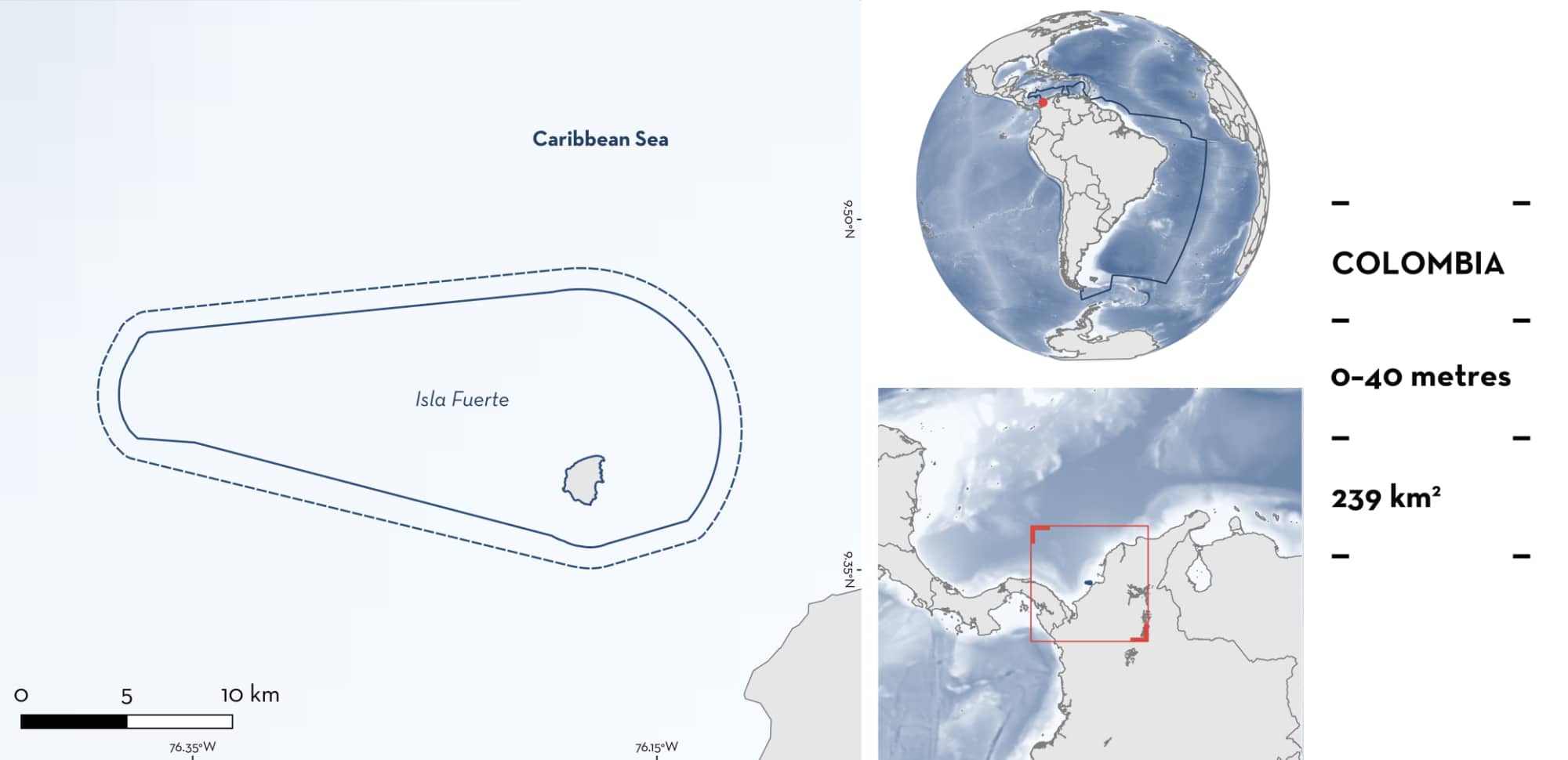ISRA FACTSHEETS
ISRA FACTSHEETS
SOUTH AMERICAN ATLANTIC REGION
Isla Fuerte
Summary
Isla Fuerte is located in south-central Colombia. It is characterised by a wide shelf with a barrier reef around the island, shallow coral banks, and extensive seagrass meadows. The area is influenced by the Sinú River. Within this area there are: threatened species (e.g., Blacktip Shark Carcharhinus limbatus) and reproductive areas (e.g., Caribbean Sharpnose Shark Rhizoprionodon porosus).
Download factsheet
Isla Fuerte
DESCRIPTION OF HABITAT
Isla Fuerte is located in south-central Colombia. It is a partially emerged reef complex with an insular platform that occupies an area of 13 km2 and hosts a barrier reef in the north, a peripheral reef belt on the edge of the platform, shallow coral banks, and extensive seagrass meadows (Díaz et al. 1996). The climate in the area is semi-arid tropical. Annual rainfall is bimodal, with ~1,300 mm of annual precipitation. The predominant current in the area is the Darien Counter Current directed to the northeast with speeds of 1–3 km/hour, the sea surface temperature remains near 27°C year-round, with a salinity value of 36. The Sinú River plume is evident on the west and south side of the area (Díaz et al. 1996).
This Important Shark and Ray Area is benthic and pelagic and is delineated from inshore and surface waters (0 m) to 40 m based on the bathymetry of the area.
CRITERION A
VULNERABILITY
Two species considered threatened with extinction according to the IUCN Red List of Threatened Species regularly occur in the area. These are the Vulnerable Blacktip Shark (Rigby et al. 2021) and Caribbean Sharpnose Shark (Carlson et al. 2021).
CRITERION C
SUB-CRITERION C1 – REPRODUCTIVE AREAS
Isla Fuerte is an important reproductive area for two shark species.
Neonate and young-of-the-year (YOY) Blacktip Sharks were regularly recorded in the area while monitoring artisanal fisheries between 2004–2012 (Gómez et al. 2007; Vishnoff-Suárez 2008; Almanza-Bernal 2009; Trejos-Méndez 2009; Salazar-Rodríguez 2012). Between 2006–2007, 96 Blacktip Sharks measuring 40–211 cm total length (TL) were recorded (Trejos-Méndez 2009). Of these, 55 (57.3%) measured <65 cm TL and were classified as neonates due to the presence of visible umbilical scars (Trejos-Méndez 2009). Three pregnant females were also recorded during this period (Trejos-Méndez 2009). Between 2006–2008, 99 Blacktip Sharks (60–212 cm TL) were recorded (Vishnoff-Suárez 2008; Almanza-Bernal 2009). Of these, 24 (24.2%) measured <72 cm TL. These individuals were considered neonates as the reported size-at-birth for the species is 38–72 cm TL (Ebert et al. 2021). Neonates/YOY were recorded mostly in August and September (Vishnoff-Suárez 2008; Almanza-Bernal 2009). During monitoring of landing surveys in March–July 2012, 72 Blacktip Sharks were recorded (Salazar-Rodríguez 2012). Of these, 21 (29.1%) were classified as neonate/YOY while another nine individuals were juveniles confirming the contemporary presence of these life stages in the area (Salazar-Rodríguez 2012).
Neonate, YOY, and pregnant Caribbean Sharpnose Sharks have been recorded in the area during monitoring of artisanal fisheries between 2004–2020 (Gómez et al. 2007; Vishnoff-Suárez 2008; Almanza-Bernal 2009; Trejos-Méndez 2009; Salazar-Rodríguez 2012; Reyes-Gómez 2018). Gravid females measuring between 69–106 cm TL were regularly recorded in directed and opportunistic sampling of artisanal fisheries in the area (Gómez et al 2007; F Gómez D unpubl. data 2024). These females were recorded and dissected from March–August and contained 1–9 embryos each (Gómez et al. 2007; F Gómez D unpubl. data 2024). In 2004, 2006, and 2007, 137 Caribbean Sharpnose Sharks measuring 33–164 cm TL were recorded (Trejos-Méndez 2009). Of these, 50 (36.4%) were classified as neonates due to the presence of umbilical scars (Trejos-Méndez 2009). Two pregnant females were also recorded during this period (Trejos-Méndez 2009). Between 2006–2008, 240 Caribbean Sharpnose Sharks (33–93 cm TL) were recorded (Vishnoff-Suárez 2008; Almanza-Bernal 2009). Of these, 66 (27.5%) measured <49 cm TL. These individuals were considered neonate/YOY as umbilical scars were found in individuals between 33–45 cm TL (Almanza-Bernal 2009). The reported size-at-birth for the species is 31–39 cm TL confirming these were neonates/YOY. These life stages were recorded mostly in March when a pregnant female with near-term embryos was also recorded (Vishnoff-Suárez 2008). Neonates were recorded during monitoring of artisanal fisheries between 2012–2020, confirming the contemporary presence of these life stages in the area (Salazar-Rodríguez 2012; Reyes-Gómez 2018; F Gómez D unpubl. data 2025). According to the Colombian fisheries statistical system, Caribbean Sharpnose Sharks were caught in the area (11 t) between 2012–2021 (De La Hoz et al. 2014, 2015, 2017; Duarte et al. 2018, 2019, 2020, 2021).
Download factsheet
SUBMIT A REQUEST
ISRA SPATIAL LAYER REQUEST
To make a request to download the ISRA Layer in either a GIS compatible Shapefile (.shp) or Google Earth compatible Keyhole Markup Language Zipped file (.kmz) please complete the following form. We will review your request and send the download details to you. We will endeavor to send you the requested files as soon as we can. However, please note that this is not an automated process, and before requests are responded to, they undergo internal review and authorization. As such, requests normally take 5–10 working days to process.
Should you have questions about the data or process, please do not hesitate to contact us.


